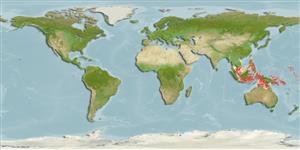分类 / Names
俗名 | 同种异名 | Catalog of Fishes(属, 种) | ITIS | CoL | WoRMS | Cloffa
Teleostei >
Gobiiformes (Gobies) >
Gobiidae (Gobies) > Gobiinae
Etymology: Trimma: Greek, trimma, -atos = something crushed (Ref. 45335); meranyx: Name from Greek words 'mera' meaning day, and 'nyx' meaning night, for ‘day-night pygmy goby’, referring to its unique colouration of a black peduncle with twin 'suns' dorsally and ventrally; noun in apposition..
Environment: milieu / climate zone / depth range / distribution range
生态学
海洋 礁区鱼类; 深度上下限 45 - 70 m (Ref. 96671).
Western Pacific: Indonesia, Papua New Guinea; photographic taken from the Philippines and Vanuatu.
大小 / 重量 / 年龄
Maturity: Lm ? range ? - ? cm
Max length : 1.9 cm SL (female)
简单描述
型态特徵 | 形态测量图
背棘 (总数): 7; 背的软条 (总数): 8; 臀棘 1; 臀鳍软条: 8. This species is distinguished by the following set of characters: a narrow bony interorbital (< 55% pupil width), predorsal midline with 8-9 scales; cycloid scales usually along the upper border of the opercle which may be in up to 3 horizontal rows; 2 (usually cycloid) cheek scales; a very slightly elongate second dorsal spine usually reaching posteriorly to between the base of the spine and the base of the second ray of the second dorsal fin; unbranched pectoral-fin rays; fifth pelvic-fin ray which branches once dichotomously and is 64-85% the length of the fourth ray; a full basal membrane connecting the inner margins of the fifth pelvic fins rays in undamaged specimens; black posterior half of the caudal peduncle with a large white spot dorsally and ventrally just anterior to the procurrent caudal fin rays is unique within the genus (Ref. 96671).
Most specimens of this 'twilight zone' species are reported from the 70 m depth range (though
have been collected as shallow as 45-55 m in the Lembeh Strait). The species do not appear to school or aggregate as with many congeners, but rather are found individually in small caves and crevices, frequently quite deep into the interstices of the reef and only visible using a strong underwater flashlight. Specimens collected were found exclusively on deep reefs sheltered from wave exposure but nonetheless exposed to currents, and although there was frequently significant silt build-up present in the caves in which they sheltered, water visibility was always good because of the significant water flow over the reefs (Ref. 96671).
Life cycle and mating behavior
成熟度 | 繁殖 | 产卵场 | 卵 | 孕卵数 | 仔鱼
Winterbottom, R., M.V. Erdmann and N.K.D. Cahyani, 2014. Three new species of Trimma (Pisces; Gobioidei) from Indonesia. Zootaxa 3838(3):367-384. (Ref. 96671)
人类利用
更多信息
俗名同种异名新陈代谢捕食者生态毒物学繁殖成熟度产卵场产卵群集孕卵数卵卵的发育
年龄范围成长体长-体重体长-体长体长-频率形态测量图型态特徵仔鱼稚鱼动力学入添量丰度BRUVS
参考文献养殖养殖信息品种遗传学Electrophoreses遗传率疾病加工NutrientsMass conversion
合作者照片Stamps, Coins Misc.声音神经毒速度泳型鳃区Otoliths脑重体重比眼睛色素
工具
特别资料
下载 XML
网络资源
Estimates based on models
Preferred temperature (Ref.
123201): 26.7 - 29, mean 27.7 °C (based on 16 cells).
Phylogenetic diversity index (Ref.
82804): PD
50 = 0.5000 [Uniqueness, from 0.5 = low to 2.0 = high].
Bayesian length-weight: a=0.01023 (0.00477 - 0.02194), b=3.02 (2.84 - 3.20), in cm total length, based on LWR estimates for this (Sub)family-body shape (Ref.
93245).
回复力 (Ref.
120179): 高度, 族群倍增时间少于 15个月 (Preliminary K or Fecundity.).
Fishing Vulnerability (Ref.
59153): Low vulnerability (10 of 100).
